Proportional fair scheduler for OFDMA wireless systems with QOS constraints
a wireless system and qos constraint technology, applied in the field of orthogonal frequency division multiple access (ofdma) technology, can solve the problems of reducing the overall change rate of other users in the system, spectral efficiency to be a more complex problem, and satisfying the quality of service requirements, so as to maintain stability
- Summary
- Abstract
- Description
- Claims
- Application Information
AI Technical Summary
Benefits of technology
Problems solved by technology
Method used
Image
Examples
Embodiment Construction
[0023]FIG. 1 is a diagram of a wireless communication system, in which the embodiments may be used. A base station 105 (illustrated as an outdoor antenna), can receive simultaneously data 100a, 100b, 100c, . . . , 100n addressed to a plurality of users 110a, 110b, 110c, . . . , 110n. The base station 105 receives queue state information of incoming signals, and channel state information of users, and allocates resources for each of the incoming and outgoing signals. Within the OFDMA framework, the resources allocated to the users come in three dimensions: time slots, frequency (bandwidth) and power. This requires the scheduler to operate with higher degree of freedom and more flexibility, and potentially higher multiplexing capacity. The scheduling embodiments take full advantage of the degree of freedom possible in the OFDMA systems. The scheduling rules must apply differently depending on the QoS requirements and the heterogeneous traffic. The multicarrier proportional fair schedu...
PUM
 Login to View More
Login to View More Abstract
Description
Claims
Application Information
 Login to View More
Login to View More - R&D
- Intellectual Property
- Life Sciences
- Materials
- Tech Scout
- Unparalleled Data Quality
- Higher Quality Content
- 60% Fewer Hallucinations
Browse by: Latest US Patents, China's latest patents, Technical Efficacy Thesaurus, Application Domain, Technology Topic, Popular Technical Reports.
© 2025 PatSnap. All rights reserved.Legal|Privacy policy|Modern Slavery Act Transparency Statement|Sitemap|About US| Contact US: help@patsnap.com



